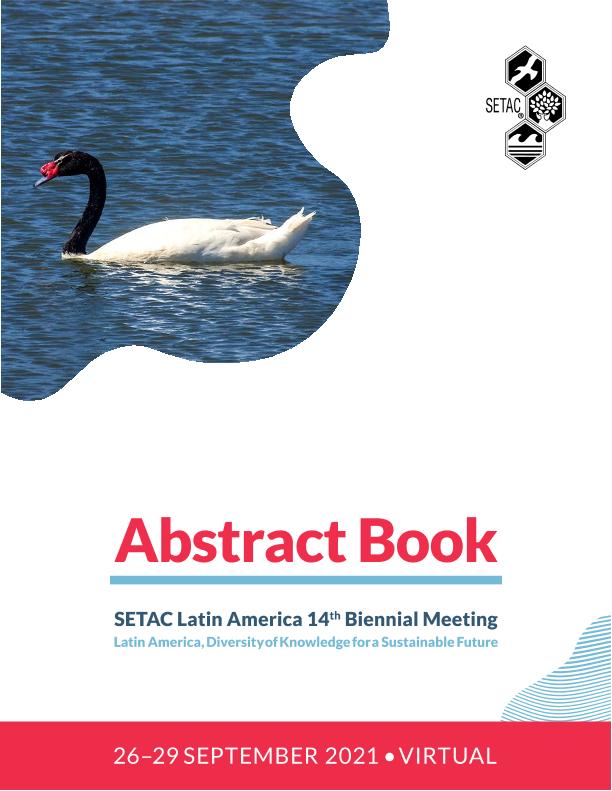Mostrar el registro sencillo del ítem
dc.contributor.author
Romero, María Belén

dc.contributor.author
Polizzi, Paula Sabrina

dc.contributor.author
Bauer, Julius
dc.contributor.author
Dolagaratz Carricavur, Arantxa

dc.contributor.author
Chiodi Boudet, Leila Natalia

dc.contributor.author
Gerpe, Marcela Silvia

dc.date.available
2023-05-24T15:40:45Z
dc.date.issued
2021
dc.identifier.citation
Assessment of Erythrocyte Nuclear Abnormalities in Oiled Spheniscus Magellanicus As a Suitable Biomarker of Genotoxicity. New Tools for Rehabilitation Centers; SETAC Latin America 14th Biennial Meeting-; Valdivia; Chile; 2021; 67-67
dc.identifier.uri
http://hdl.handle.net/11336/198585
dc.description.abstract
Genome stability is mainly influenced by individual genetic information and environmental factors and it can be used as index for an individual?s reaction on environmental impact and stress, such as pollutants. When birds are exposed to less than acutely lethal dosages, oil can cause a wide range of adverse effects, including hemolytic anemia, decreased nutrient absorption and decreased immune function. Evaluation of gene and cytotoxicity is an interesting field and valuable tool in environmental toxicology, although few studies have been conducted in wild birds. Among the methods for the estimation of genome instability is the evaluation of erythrocyte nuclear abnormalities (ENAs), which may be useful in field research of birds. The aim was to evaluate ENAs frequency in oiled Magellanic penguin (Spheniscus magellanicus) as biomarkers of genotoxicity. In addition, we assessed penguin recovery ability after rehabilitation process. Peripheral blood samples of oiled (n=29) and post-rehabilitation (n=21) Magellanic penguins were taken during 2011 and 2013 in Buenos Aires, Argentina. Blood smears were performed for analysis of ENAs, which included micronucleus, lobed nucleus, tailed nucleus, two-lobed nucleus, budding nucleus, nucleus with cavity, kidney-shaped nucleus and unknown nuclear malformation. Considering the total of ENAs, oiled penguins presented significantly higher levels than post-rehabilitation animals. In particular, oiled penguins presented higher values of the following ENAs: tailed nucleus, budding nucleus, kidney-shaped nucleus, nucleus with cavity and unknown nuclear malformation. No significant differences were found between groups for micronucleus and lobed nucleus. The present study represents the first approach on assessing not only the frequency of MN but also other ENAs in S. magellanicus. The micronucleus is the most widely used genotoxicity marker in birds. However, micronuclei was found in low frequency in all Magellanic penguins, indicating that the evaluation of other ENAs is a better biomarker to evaluate genotoxicity in the species. The results show that chronic oiling produces genotoxicity in Magellanic penguin, and that the rehabilitation process is adequate to reverse this damage. However, although the number of ENAs decreases in post-rehabilitation penguins, it is not known what the long-term damage is. Therefore it is important to record the effects of stressors such as oil for long-term comparisons.
dc.format
application/pdf
dc.language.iso
eng
dc.publisher
Society of Environmental Toxicology and Chemistry

dc.rights
info:eu-repo/semantics/openAccess
dc.rights.uri
https://creativecommons.org/licenses/by-nc-sa/2.5/ar/
dc.subject
STRESS RESPONSE
dc.subject
BIOMARKERS
dc.subject.classification
Biología Marina, Limnología

dc.subject.classification
Ciencias Biológicas

dc.subject.classification
CIENCIAS NATURALES Y EXACTAS

dc.title
Assessment of Erythrocyte Nuclear Abnormalities in Oiled Spheniscus Magellanicus As a Suitable Biomarker of Genotoxicity. New Tools for Rehabilitation Centers
dc.type
info:eu-repo/semantics/publishedVersion
dc.type
info:eu-repo/semantics/conferenceObject
dc.type
info:ar-repo/semantics/documento de conferencia
dc.date.updated
2022-11-04T15:27:22Z
dc.journal.pagination
67-67
dc.journal.pais
Chile

dc.journal.ciudad
Valdivia
dc.description.fil
Fil: Romero, María Belén. Consejo Nacional de Investigaciones Científicas y Técnicas. Centro Científico Tecnológico Conicet - Mar del Plata. Instituto de Investigaciones Marinas y Costeras. Universidad Nacional de Mar del Plata. Facultad de Ciencias Exactas y Naturales. Instituto de Investigaciones Marinas y Costeras; Argentina
dc.description.fil
Fil: Polizzi, Paula Sabrina. Consejo Nacional de Investigaciones Científicas y Técnicas. Centro Científico Tecnológico Conicet - Mar del Plata. Instituto de Investigaciones Marinas y Costeras. Universidad Nacional de Mar del Plata. Facultad de Ciencias Exactas y Naturales. Instituto de Investigaciones Marinas y Costeras; Argentina
dc.description.fil
Fil: Bauer, Julius. Universidad Nacional de Mar del Plata; Argentina
dc.description.fil
Fil: Dolagaratz Carricavur, Arantxa. Consejo Nacional de Investigaciones Científicas y Técnicas. Centro Científico Tecnológico Conicet - Mar del Plata. Instituto de Investigaciones Marinas y Costeras. Universidad Nacional de Mar del Plata. Facultad de Ciencias Exactas y Naturales. Instituto de Investigaciones Marinas y Costeras; Argentina
dc.description.fil
Fil: Chiodi Boudet, Leila Natalia. Consejo Nacional de Investigaciones Científicas y Técnicas. Centro Científico Tecnológico Conicet - Mar del Plata. Instituto de Investigaciones Marinas y Costeras. Universidad Nacional de Mar del Plata. Facultad de Ciencias Exactas y Naturales. Instituto de Investigaciones Marinas y Costeras; Argentina
dc.description.fil
Fil: Gerpe, Marcela Silvia. Consejo Nacional de Investigaciones Científicas y Técnicas. Centro Científico Tecnológico Conicet - Mar del Plata. Instituto de Investigaciones Marinas y Costeras. Universidad Nacional de Mar del Plata. Facultad de Ciencias Exactas y Naturales. Instituto de Investigaciones Marinas y Costeras; Argentina
dc.relation.alternativeid
info:eu-repo/semantics/altIdentifier/url/https://sla2021.setac.org/es/
dc.conicet.rol
Autor

dc.conicet.rol
Autor

dc.conicet.rol
Autor

dc.conicet.rol
Autor

dc.conicet.rol
Autor

dc.conicet.rol
Autor

dc.coverage
Internacional
dc.type.subtype
Congreso
dc.description.nombreEvento
SETAC Latin America 14th Biennial Meeting-
dc.date.evento
2021-09-26
dc.description.ciudadEvento
Valdivia
dc.description.paisEvento
Chile

dc.type.publicacion
Book
dc.description.institucionOrganizadora
Society of Environmental Toxicology and Chemistry
dc.source.libro
SETAC Latin America 14th Biennial Meeting
dc.date.eventoHasta
2021-09-29
dc.type
Congreso
Archivos asociados
